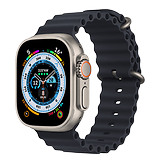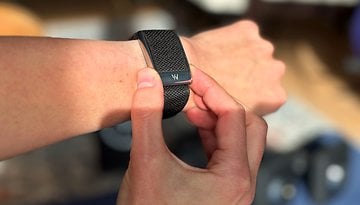Apple Watch Ultra review: Premier SUV on the wrist


The Apple Watch Ultra is the all-around best smartwatch for die-hard iPhone users, there is no question about that. But does Apple manage to convince ambitious athletes and outdoor enthusiasts with its latest and most expensive watch? In the NextPit review, we push the Apple Watch Ultra to its limits.
Good
- Cool, indestructible design
- Outstanding smartwatch features
- Extremely accurate heart rate measurement
- Very accurate multi-band GPS
Bad
- Works only with iOS
- Improved battery life compared to its predecessor
- No GPX import/export, no on-device navigation
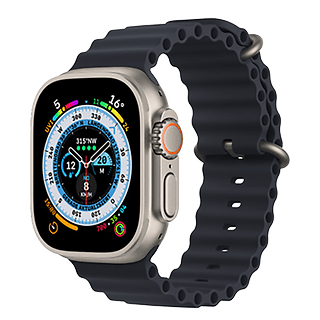
The Apple Watch Ultra in a nutshell
The Apple Watch Ultra costs $799 in the US, and thus twice as much as the smaller Watch 8. Hardware-wise, the Ultra Watch is actually a Watch 8 underneath the hood. Both the Ultra and the 8 are powered by Apple's S8 processor, and both feature the W3 chip as well as the U1 chip for UWB. And of course, both models run watchOS 9.
- Also interesting: All current Apple Watch models compared
Apart from the much larger format with more robust materials and an additional button, the Watch Ultra also has some features specially meant for athletes and outdoor enthusiasts. For instance, the extremely accurate dual-band GPS, a triathlon mode, and the alarm siren. In terms of sports features, however, Apple lags behind the high-end sports watches from Garmin and others, at least for now.
Design and display
With its fat titanium case and large display, the Apple Watch Ultra looks much bulkier than all other watches. The new controls are pleasing, and the indestructible 2,000-nits display is a pure delight.
What I like:
- Chic, practical design.
- Extremely robust materials.
- Third button on the case.
- Fantastic and very bright display.
What I dislike:
- Button activated by accident on occasion.
The design of the Apple Watch Ultra is clearly in the same vein as the other Apple smartwatches, but at the same time, it comes across as bulkier. With its 49 mm case, it is clearly more imposing than the Watch 8, be it in the 44 or 46 mm format. It is also thicker on the wrist than the Watch 8 models at 14.4 versus 10.7 mm. Tipping the scales at 61.3 g, the watch is also quite heavy.

On the right side of the watch is the digital crown, which can be rotated and pressed as usual. To protect it from accidental activation, it is enclosed in a recess that is about 2 mm deep. During the review, however, I repeatedly activated Siri accidentally by pressing the crown for a long time with my angled wrist. Accidentally twisting the crown did not happen in the review, but it can still be operated decently while wearing medium-thick gloves. Very nice!

Pressing the digital crown calls up the app overview, either in the form of a grid or list. By twisting the crown, you can scroll through lists, zoom into displays or, very handy for couch potatoes and movie lovers, transform the display in the Watchface into dark mode with a red-and-black display. Apple also accommodates a second button in the crown protection with which you can call up the most recently used apps.
On the left of the case is the action button in bright orange. It opens the workout dialog by default, but you can also reassign the button. For instance, by selecting certain workouts, underwater mode, iPhone search, or a shortcut to Shazam. A long press on the action button opens the emergency menu with siren, medical ID, backtrack, and emergency call.

If you hold the button down even longer, the siren starts automatically, which can be heard from a distance at up to 86 dB in its strikingly shrill warning tone. Otherwise, the function changes depending on the context: During a sporting activity, for example, you mark a new lap with the action button.
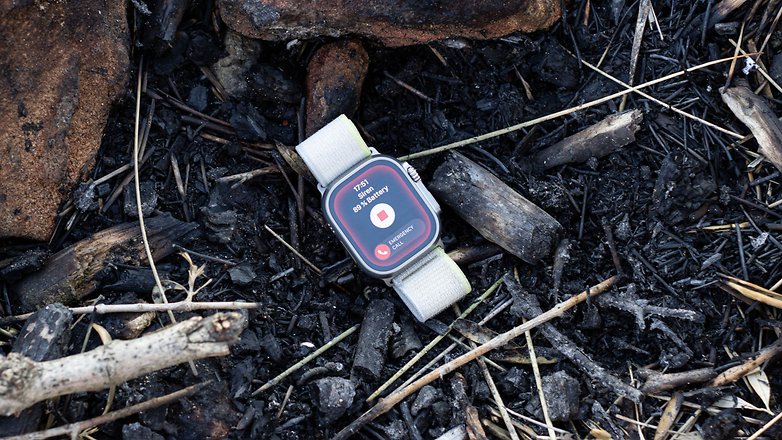
And then, of course, there is the touchscreen display. The AMOLED panel is doubly protected. First, the screen is completely flat and is recessed within the titanium casing by a mere millimeter. Secondly, there is a sapphire glass over the panel that does not have the slightest scratch after two months of use including endless gardening sessions filled with gravel and stones. This also applies to the titanium case, which also looked new. The downside? You only get the Apple Watch Ultra in one color.
The display of the Apple Watch Ultra worked great under all conditions. With a peak brightness of 2,000 nits, it is still perfectly legible even under the blazing winter sun. Thanks to a 502 x 410 pixels resolution, the LTPO panel is razor-sharp and is pleasing to scroll through with a buttery-smooth display.

Operating system: watchOS 9
Lightning-fast, intuitive and versatile: watchOS 9 on the Apple Watch Ultra is an utterly convincing proposition from A to Z. Neither smartphone manufacturers like Google or Samsung nor third-party suppliers are able to offer a smartwatch that is so seamlessly interwoven with the entire ecosystem at the moment.
What I like:
- Setup is incredibly simple.
- Very flexible interface.
- Accident detection and ovulation tracking.
What I dislike:
- Doesn't work well without the iPhone.
The fact that the Apple Watch Ultra and watchOS 9 are tailor-made for the iPhone is immediately noticeable during setup. The setup takes just a few minutes, and all compatible apps are directly available on the smartwatch and ready for use, ranging from Nuki for the smart door lock to Spotify, Shazam, and Komoot. Apple Pay also works right out of the box. It really couldn't be simpler, at least with an iPhone. This is because the Watch Ultra won't run without an Apple phone.

On board the Apple Watch Ultra include all the new features that Apple introduced in September 2022 for watchOS 9 and current Watch models. These include, ovulation tracking and accident detection, which can also be found on the Apple Watch 8. Due to the lack of two X chromosomes and a car accident, respectively, I could not/must not try out both functions during the review.
Also new in watchOS 9 is the WayFinder watchface, which you can see in many of the photos in this article. What I particularly liked here: By turning the digital crown, you can display the watchface in night mode with a black-and-red display. We've already covered watchOS 9 and the new features in great detail, where you can find all details about the operating system of the Apple Watch Ultra in the linked article.

Fitness & Sensors
Apple also wants to win the hearts of ambitious athletes with the Watch Ultra. The dual-band GPS and the longer battery life in particular should be the deciding factors with this model. While the Ultra watch shines in many areas, there are also a few shortcomings.
What I like:
- PPG sensor measures the pulse extremely accurately.
- Multi-band GPS is very accurate.
- Successful integration of Fitness+.
What I dislike:
- Limited support for external sensors.
- No independent map navigation.
The Apple Watch Ultra offers extensive workout functions from running to triathlon to kickboxing, which can be configured in great detail. Thus, you can configure the information shown on the display separately for each individual workout. The new metrics for running efficiency are also practical here, so you can directly fine-tune cadence and ground contact time while running.

I also like the fact that you can configure workouts yourself. For example, you can create a customized interval workout including warm-up and cool-down sessions.

Of course, the Apple Watch Ultra also works with Fitness+. As soon as you start a workout on the iPhone or iPad, the Apple Watch Ultra switches to the corresponding tracking mode and automatically records the workout.
Heart rate measurement and others
The Apple Watch Ultra uses the same optical PPG sensor for measuring pulse, SpO2, and HRV as the Apple Watch 8. The sensor is impressively accurate and delivers practically identical values as a chest strap from Garmin for many sports. The average heart rate determined via Garmin Forerunner 955 with chest strap and via Apple Watch Ultra during a 10-kilometer run was 156 beats per minute in each case. The peak heart rates were also virtually identical at 174 and 175 beats, respectively.

Only in sports that tend to require your wrist to be bent or strained under a heavy load does the Watch Ultra deliver slightly lower values. However, this effect occurs with all optical wrist-based heart rate sensors and is less pronounced with the Apple smartwatch than with all other sports watches I have reviewed so far.

A welcome new feature is that heart rate zones can now be defined either automatically or manually. With the correspondingly configured display, you can then train precisely according your desired heart rate zone.
If you want to be more precise, you can also connect Bluetooth chest straps to the Apple Watch Ultra, which will then only communicate the pulse. Unfortunately, the Apple smartwatch does not support cadence or cadence sensors with Bluetooth. In view of the advertised triathlon capabilities, that is a shame.

Finally, the Apple Watch Ultra also determines your running power. However, it is a bit unfortunate that the measurement stops as soon as you stop jogging and switch to walking on very steep hills. This unfortunately distorts the result when you are running in very mountainous terrain.
GPS and navigation
The Apple Watch Ultra offers a new dual-band GPS module that delivers impressively accurate results in the review. The GPS tracks are practically identical to those of a Garmin Forerunner 955, which also records routes with dual-band GPS, but even more accurately.

The Apple Watch Ultra smooths the GPS tracks a tad more than the Garmin watch. And in the upper third of the track section, a tight switchback on the Watch Ultra looks like I've run a section of the track twice. In practice, however, the difference hardly matters. On a 10-kilometer course, the two smartwatches were just 20 meters apart as seen in the following example.

The Apple Watch Ultra also offers a Backtrack function that always guides you back to the starting point if you get lost. This works well in practice, but is implemented in a rather rudimentary manner. You can only see the covered distance on a compass, in the following picture a straight line. Unfortunately, there is no map display.

What is still missing on the Apple Watch Ultra is a way to import maps in GPX format, for example, or export recorded routes with the on-board means. This feature is available on almost all sports watches and also on more and more smartwatches, such as the Samsung Galaxy Watch 5 Pro (review).
Sleep and recovery
Last but not least, the Apple Watch Ultra records your sleep and to a limited extent, your recovery. Unfortunately, we cannot evaluate the measurement of the individual sleep phases due to the lack of a sleep lab. However, the times you fall asleep and wake up coincide with reality - and very accurately with the measurements of the Garmin Forerunner 955, which I tested over long distances simultaneously with the Watch Ultra.
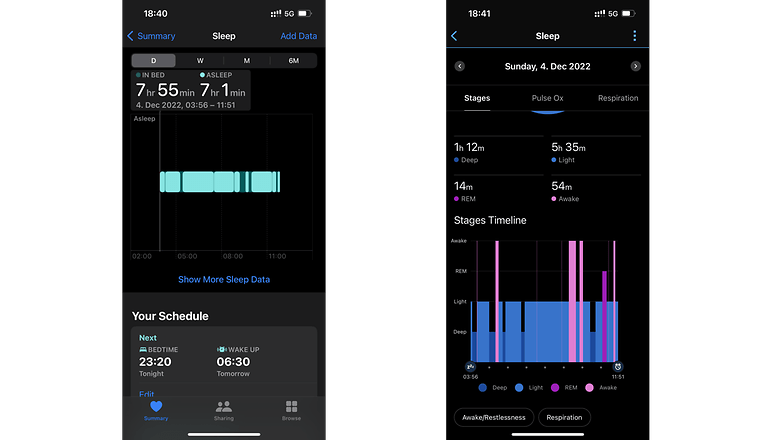
When it comes to recovery measurement, the Apple Watch Ultra is currently still holding back a lot. It does measure heart rate variability, an important factor for your current form, but only displays the value under numerous layers in Apple Health. You will not find a function like Fitbit's Daily Form Index or Garmin's Body Battery on the Apple Watch.
Battery and charging
The Apple Watch Ultra has improved its battery life enormously compared to all previous Watch models. The improved runtime should now easily suffice for the vast majority of users.
What I like:
- Battery life is significantly better than previous Apple Watches.
- Very high-quality charging cable.
What I dislike:
- Has to be charged after two days at the latest.
- Slow charging speed.
The good news is that the Apple Watch Ultra will practically never run out of battery in a single day. With twelve hours of runtime in GPS workout mode, you will probably even manage an Ironman with the watch, even if your name is not Jan Frodeno (7:27:53). In low-power mode with throttled LTE activity, the Apple Watch Ultra should even last the 17 hours that are usually the time limit for an Ironman even.
I did not participate in an Ironman event for the review, but Apple's specifications are quite realistic. One hour of outdoor activity with activated GPS typically consumes six to eight percent of battery capacity. In smartwatch mode, Apple promises 36 hours of runtime, which I always easily achieve with about 30 to 90 minutes of exercise per day. I usually charge the Apple Watch Ultra every two days during the review. With the help of the new energy-saving mode, the Apple Watch Ultra is supposed to last 60 hours in smartwatch mode.

Unfortunately, charging always gets in my way a bit. Since the watch charges quite slowly, it's not enough to just plug the watch into the charger for 15 minutes while taking a shower. It takes around 10 minutes to pump 10 percent capacity into the battery, taking exactly 100 minutes to hit 100 percent in the review:
- Start: 10 percent remaining battery capacity
- 10 minutes: 19 percent
- 20 minutes: 30 percent
- 30 minutes: 37 percent
- 40 minutes: 48 percent
- 50 minutes: 58 percent
- 60 minutes: 67 percent
- 70 minutes: 77 percent
- 100 minutes: 100 percent
Dear Apple: How about an ultra-light sleep tracker à la Whoop 4.0 (review) for the night? Then I can simply charge the Apple Watch Ultra together with the smartphone on the nightstand. Speaking of charging: Apple includes a charging puck with the Watch Ultra that, unlike the adapters of the "normal" Watch models, pleases with a very high-quality, fabric-sheathed cable.
Final verdict
At the end of the day, the Apple Watch is a fantastic smartwatch and an absolute no-brainer for the vast majority of iPhone users. There is no smartwatch that is so diverse and so successfully integrated into any ecosystem. On the sports and outdoor features side, the Apple Watch Ultra ends up being an SUV for the wrist with that certain "I could if I wanted" feeling; a lifestyle promise of being able to throw yourself into the Ironman in Hawaii or into the wilderness with the watch at any time.
Sure, battery life is vastly improved over any other of its Watch predecessors, and there are many well-done sports features, including the super-accurate multi-band GPS, the reliable PPG sensor, and the awesome Apple Fitness+. The siren can also be heard far and wide with its piercing sound and can save lives.
But for those who seriously want to run ultramarathons and triathlons or who want to spend days in the wilderness, a bit more seat height and ground clearance are not enough if features like GPX import, independent on-device navigation or support for cadence sensors remain missing. They will continue to buy a Garmin smartwatch instead of the fancy Apple SUV.
Apple has been catching up in seven-mile increments in 2022, and remains a long way from reaching its destination. They are on the right path, though!
- Read more: The best smartwatches in 2023
